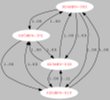|
One of the uses of HSMM-Mesh is using it for a VoIP telephone system, sort of like our very own PBX system. A free server available for download is 3CX, based on the open-source Asterisk system. One issue has been setting up a VoIP that works across the mesh nodes. Most of the time, the administrators would set the nodes into a X-HOST DMZ mode, due to the problems with port forwarding. Here I will lay out the steps to make the server work behind a mesh node that is in NAT mode. I needed mine to be in NAT, since that same node forwards other ports to other services that live on my LAN. You can use either the free softphone software or analog telephone adapters (ATA) to connect to the system.
Download and install 3CX to a Windows PC/server. Take all the defaults during install, entering in any information specific to your installation (IP addresses, callsign, etc).
Certain settings will need to be set to work properly across mesh nodes. Click Settings, Advanced, and under Settings for Direct SIP, you will need to check the box "Allow calls to/from external SIP", then under "Local SIP Domain", you need to enter in the 10.x.x.x IP address of the node that will service the 3CX system. By default, this had a LAN IP, and it would not allow calls across the mesh. Once it was set to the WLAN 10.x.x.x IP, calls could be made from node to node.
You can now move on to creating extensions for every one on your mesh. For ease of use, I chose to use the last 3 characters of each person's callsign. So for me, K5KTF, KTF is 583 on a standard telephone keypad. I added about 30 extensions for those on the mesh here in Austin, and so far I havent had any duplicate numbers. And with this scheme, we wont need a directory, since each person's number IS their callsign. If I run into duplicate numbers, I may move to the last FOUR characters. For the phone end, I dedicated a node and set it for 1-host DMZ mode, and hooked the ATA and phone to that node. Set for DHCP mode, and assigned the extension and password in the ATA (would be the same for softphone software).
|



